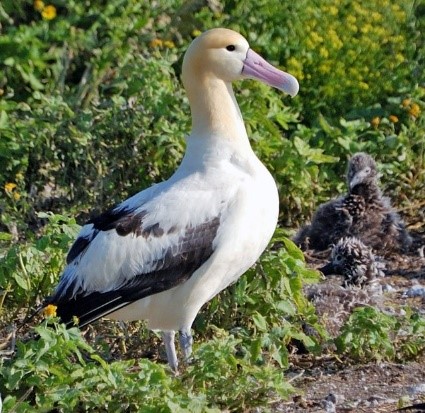Description

Disclaimer: Copyright infringement not intended.
Context
- Albatrosses are threatened with extinction — and climate change could put their nesting sites at risk.
Albatrosses
Introduction:
- Albatrosses are large seabirds belonging to the family Diomedeidae, known for their exceptional flying abilities and extensive oceanic journeys.
- These birds have long wingspans, well-adapted for gliding over the open sea.
Species and Range:
- There are around 22 species of albatrosses, distributed primarily in the Southern Ocean and the North Pacific.
- Their playground is the vast Southern Ocean — the region between the latitude of 60 degrees south and the continent of Antarctica.
- Notable species include the Wandering Albatross, the Black-browed Albatross, and the Laysan Albatross.
Physical Characteristics:
- Long Wingspan: Ranges from 6 to 11 feet, the longest wingspan of any living bird.
- Plumage: Typically white with dark markings, varying among species.
- Adaptations: Tubular nostrils on the top of their bills, enabling efficient salt excretion.

Flight Abilities:
- Dynamic Soaring: Albatrosses utilize wind gradients and air currents to cover vast distances with minimal energy expenditure.
- Extended Flights: Known for long-duration flights, sometimes covering thousands of miles without flapping their wings.
Feeding Habits:
- Diet: Mainly consists of fish, squid, and other marine organisms.
- Scavenging: Some species are adept scavengers, often following ships for discarded food.
Breeding and Life Cycle:
- Mating Rituals: Elaborate courtship displays involving synchronized dancing and vocalizations.
- Nesting: Albatrosses typically nest on remote islands.
- Slow Reproduction: Long gestation periods and low reproductive rates; some species may take several years between breeding attempts.
Conservation Status:
- Threats: Albatross populations face challenges such as bycatch in fishing gear, plastic pollution, and habitat destruction.
It faces huge risks while in the open ocean, in particular, due to bycatch from longline fishing trawlers.
- Conservation Efforts: Various initiatives focus on reducing bycatch, protecting nesting sites, and raising awareness about the conservation needs of these birds.
- The Wandering Albatross, Diomedea exulans, is classified as Vulnerable on the IUCN Red List of Threatened Species.
Notable Facts:
- Albatrosses are among the longest-lived birds, with some individuals reaching ages of 60 years or more.
- They have highly developed olfactory abilities, aiding them in locating prey over vast distances.
Climate Change Impact on Albatrosses: Marion and Prince Edward Islands
Geographical Significance:
- Marion Island and Prince Edward Island, situated 2,300km south of South Africa, serve as vital land masses in the expansive Southern Ocean.
Breeding Population:
- Home to approximately half of the global wandering albatross breeding population, estimated at 20,000 mature individuals.
Temperature Increase and Climate Shifts:
- Marion Island's temperature rose by 1.2°C by 2003 compared to the 1950s.
- Precipitation declined by 25%, leading to reduced cloud cover and increased sunshine hours.
- Permanent snowline, once present, disappeared, marking significant climate changes.

Vegetation and Range Shifts:
- Sub-Antarctic vegetation experienced substantial shifts over 40 years, with species moving to higher elevations for cooler temperatures.
- Wind speeds in the Southern Ocean have increased and are expected to continue, impacting nesting area suitability.
Predicted Consequences:
- Ongoing and future changes may force albatross nesting sites to higher elevations due to temperature, vegetation, and wind alterations.
- Potential reduction in suitable nesting areas, posing challenges to the breeding success and survival of wandering albatross populations.
Conclusion:
- Albatrosses play a crucial role in marine ecosystems, and their conservation is vital for maintaining the balance of oceanic biodiversity.
|
PRACTICE QUESTION
Q. Which bird family faces threats of extinction, with climate change posing risks to their nesting sites, particularly on Marion and Prince Edward Islands?
1.Seagulls
2.Albatrosses
3.Pelicans
4.Falcons
Answer 2. Albatrosses
Q. What is the primary adaptation that enables albatrosses to efficiently excrete salt while flying over the open sea?
- Tubular nostrils
- Long wingspan
- Synchronized dancing
- Plumage variations
Answer: 1. Tubular nostrils
Explanation: Albatrosses have tubular nostrils on the top of their bills, which is a unique adaptation that facilitates efficient salt excretion. This adaptation helps them cover vast distances over the open sea by utilizing wind gradients and air currents. The tubular nostrils play a crucial role in their physiological adaptation to the marine environment, enabling them to drink seawater and excrete excess salt efficiently.
|












